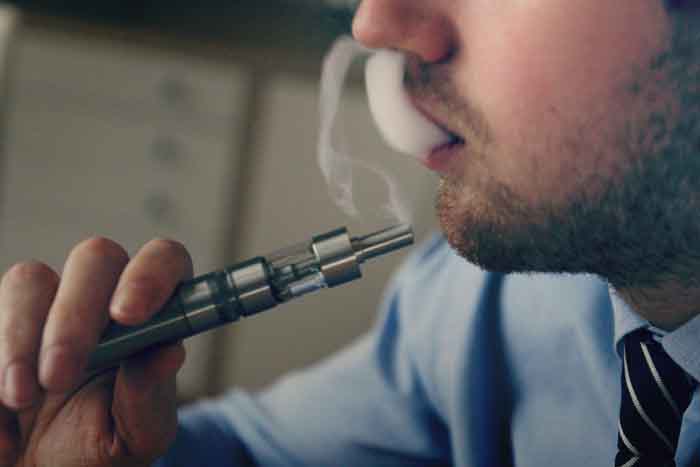The American Heart Association is pretty clear on where they stand when it comes to e-cigarettes and vaping. Their initial policy statement on the products leaves little room for wiggling. The association says that, while unknowns still abound regarding the electronic cigarette industry, e-cigarettes are dangerous “because they target young people, can keep people hooked on nicotine and threaten to ‘re-normalize’ tobacco use.”
The AHA says that “based on current evidence,” the association’s position is that e-cigarettes which contain nicotine are “tobacco products and should be subject to all laws that apply to these products.”
On the other side of the issue, the e-cigarette industry is putting on their own full-court press. The Munich American Reassurance Company recently produced a survey for 150 life insurance companies which said that 9 out of 10 insurance company execs feel electronic smokes and tobacco cigarettes are essentially the same as their use relates to insurance premiums.
Three Potential Reasons E-cigarettes Are a Major Issue for Insurers
- E-cigarettes are relatively new to the market.Even though e-cigarettes have been on the market for more than a decade, insurance companies take a much longer view as they write policies which will be in effect for decades. Insurers are as yet unconvinced that e-cigarettes can be effectively used as smoking cessation tools. Insurers are also awaiting research and studies before they sign off on the technology.
- E-cigarettes Have Generated Controversy.Can e-cigarettes be effective tools to help smokers quit smoking tobacco products? Will the very existence of e-cigarettes turn kids – and current non-smokers – into smokers? To insurers, the technology represents an additional layer of risk.
- E-cigarettes Are Unregulated.With the FDA and lawmakers still engaged in deciding how to regulate and tax e-cigarettes, official stances and laws are still in their formative stages. To insurers, this lack of clear regulation represents risk, and any such variables won’t go unnoticed.
Health Insurance and E-Smoking
The current provisions of the Affordable Healthcare Act means insurers can only inquire about an applicant’s age, their place of residence, how many people are in their family and whether or not they use tobacco products. For e-cigarette users, answering the tobacco question means they can answer – and truthfully – that they don’t use ‘tobacco’ or ‘smoke.’
It’s likely to come down to a debate about what defines ‘a smoker,’ and until the FDA specifies their set of regulations, insurance companies will most certainly choose to charge “vapers” for their e-cigarette use, but only if e-smokers choose to disclose their use.
The latest e-cigarettes models are often referred to as “clearomizers,” “tankomizers,” or “carotanks.” They hold several milliliters of fluid encased in refillable reservoirs and are operated via batteries with voltages from 3.0 to 7.0 V.
Within the atomizer itself a resistance wire is encircled around a “wicking” device which draws the fluid in, and when activated by a sensing device, the resistance wire rapidly heats up. That heating action turns the wicked fluid into an aerosol for inhalation by a user. It’s the resistance and voltage driving the heating element – and the makeup of the material used to build the heating element is made – which determines the the amount and quality of the aerosol pumped out by the atomizer.
Some vaping and e-cigarette technologies include programmed pumps, specific diaphragms and micropumps within their microelectromechanical system designs. Devices such as there provide a programmed combination of e-liquid delivery to the aerosol generator.
A number of the devices are pretty sophisticated and contain integrated circuits, programmable logic and electronic components which can display ‘use cycle: and safety warnings information.
The American Heart Association has already taken an unequivocal stance on vaping which calls for strong new regulations to prevent sales and marketing of e-cigarettes to the young and calls for ongoing research into the technology’s potential impact on health.
“Over the last 50 years, 20 million Americans died because of tobacco. We are fiercely committed to preventing the tobacco industry from addicting another generation of smokers,” says Nancy Brown, CEO of the American Heart Association. “Recent studies raise concerns that e-cigarettes may be a gateway to traditional tobacco products for the nation’s youth, and could renormalize smoking in our society. These disturbing developments have helped convince the association that e-cigarettes need to be strongly regulated, thoroughly researched and closely monitored.”
The AHA has called for a federal ban on e-cigarettes use by minors, and they see “e-cigarettes” as “another entry point for nicotine addiction among young people.”
The Heart Association is also unconvinced when it comes to the use of e-cigarettes in tobacco-cessation counseling, and they say there’s a lack of any evidence that establishes e-cigarettes as “a primary smoking-cessation aid.”
While a handful of studies have said using e-cigarettes may help smokers quit using tobacco and they they might also be slightly more effective than nicotine patches, the AHA says they “will continue to encourage clinicians to use proven smoking-cessation strategies as the first line of treatment for any patient.”
But the bottom line when it comes to using e-cigarettes is this: When it comes time to purchase life insurance, insurers will consider smoking e-cigarettes “being a smoker” and hold that nicotine addiction, no matter how the substance is delivered, will affect standard insurance rates for the near future.
Greg Conley, the president of the American Vaping Association, says life and health insurers cast “vapers” as “smokers.”
“A lot of the insurance applications say, ‘Do you use tobacco products?’ I think that 90-plus percent of former cigarette smokers who have quit with e-cigarettes and no longer use tobacco are going to mark ‘no,'” says Conley. “The problem is, they may end up testing positive for nicotine, which is what the insurance company uses to make a tobacco determination.”
Insurance insiders say most companies do test for the presence of nicotine byproducts, but they test for levels which would occur above what might be produced by secondhand smoke. They say the larger national life insurance underwriters consider nicotine delivery as the central issue at play.













